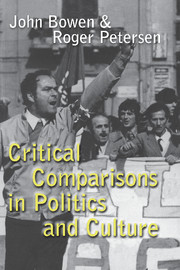Book contents
- Frontmatter
- Contents
- List of Figures
- List of contributors
- Acknowledgments
- 1 Introduction: critical comparisons
- 2 National revivals and violence
- 3 Mechanisms and structures in comparisons
- 4 Comparative methodologies in the analysis of anthropological data
- 5 The role of comparison in the light of the theory of culture
- 6 Case studies of contemporary job loss
- 7 Defining the contours of an Islamic reform movement: an essay in successive contrasts
- 8 Producing an analytic narrative
- 9 Political consciousness on Boa Ventura: 1967 and 1989 compared
- 10 Comparisons in the context of a game theoretic argument
- 11 The role of microhistories in comparative studies
- List of references
- Index of authors
- Subject index
4 - Comparative methodologies in the analysis of anthropological data
Published online by Cambridge University Press: 28 January 2010
- Frontmatter
- Contents
- List of Figures
- List of contributors
- Acknowledgments
- 1 Introduction: critical comparisons
- 2 National revivals and violence
- 3 Mechanisms and structures in comparisons
- 4 Comparative methodologies in the analysis of anthropological data
- 5 The role of comparison in the light of the theory of culture
- 6 Case studies of contemporary job loss
- 7 Defining the contours of an Islamic reform movement: an essay in successive contrasts
- 8 Producing an analytic narrative
- 9 Political consciousness on Boa Ventura: 1967 and 1989 compared
- 10 Comparisons in the context of a game theoretic argument
- 11 The role of microhistories in comparative studies
- List of references
- Index of authors
- Subject index
Summary
Though anthropology is almost invariably characterized in textbooks as a comparative discipline, it is striking how unsympathetic social and cultural anthropologists of different theoretical persuasions are to each others' formal comparative operations, and how little agreement there has been on what might constitute “the comparative method” in anthropology. Yet the explicit discussions and critiques of comparisons that we see within anthropology tend to focus on opposed theoretical positions, or the rejection of the substantive assertions of contesting colleagues, and rarely on clarifying the critical issues that the comparative analysis itself raises. As a result, there has been little movement towards any common standards of methodology for comparative operations. In the following, I will discuss the uses of comparison I have made in my analyses of field materials from the Ok area of New Guinea and from Bali, and reflect on what I see as crucial issues in the uses of comparative methodology on these materials, especially in view of developments in contemporary culture theory.
Zoology and gross anatomy provided early models for comparative methodology in anthropology: in the taxonomies of museum collections and the delineation of culture areas, as well as in the structuralism of Radcliffe-Brown. I believe that unanalyzed templates from these early exercises may still be with us and affect how we pursue our comparisons. The key step in the study of comparative anatomy is to identify equivalent structures, that is, the parts of two different organisms to compare. The criteria for such equivalence rely either on similarities of function (for example, “limbs,” “eyes,” or “the circulatory system” in two different organisms), or they point to an obtrusive similarity of pattern (for example, a segmented structure and its various modifications between two different organisms, or indeed between the different segments of one organism).
- Type
- Chapter
- Information
- Critical Comparisons in Politics and Culture , pp. 78 - 89Publisher: Cambridge University PressPrint publication year: 1999
- 9
- Cited by



